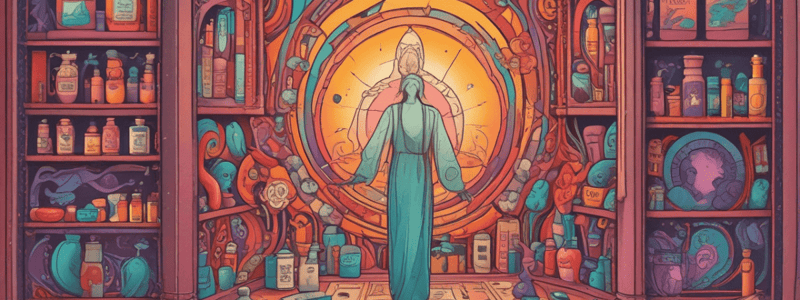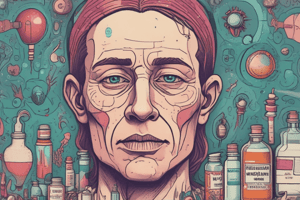Podcast
Questions and Answers
Which of the following antidepressants is a selective serotonin reuptake inhibitor?
Which of the following antidepressants is a selective serotonin reuptake inhibitor?
- Phenelzine
- Fluoxetine (correct)
- Bupropion
- Amitriptyline
What is the primary mechanism of action of antipsychotic drugs in treating schizophrenia?
What is the primary mechanism of action of antipsychotic drugs in treating schizophrenia?
- Inhibition of acetylcholine receptors
- Blockage of dopamine and serotonin receptors (correct)
- Activation of GABA receptors
- Stimulation of dopamine and serotonin receptors
Which of the following is NOT a hallmark symptom of schizophrenia?
Which of the following is NOT a hallmark symptom of schizophrenia?
- Disorganized thinking
- Delusions
- Hallucinations
- Insomnia (correct)
What is the term for drug-induced movement disorders caused by antipsychotic medications?
What is the term for drug-induced movement disorders caused by antipsychotic medications?
Which of the following is an example of an atypical antipsychotic?
Which of the following is an example of an atypical antipsychotic?
What is the estimated prevalence of schizophrenia in the world's population?
What is the estimated prevalence of schizophrenia in the world's population?
Which of the following antidepressants is a monoamine oxidase inhibitor?
Which of the following antidepressants is a monoamine oxidase inhibitor?
What is the term for emotional disturbances characterized by mood that is consistently low?
What is the term for emotional disturbances characterized by mood that is consistently low?
What is the outcome of continued blockade of dopamine neurotransmission by antipsychotic drugs?
What is the outcome of continued blockade of dopamine neurotransmission by antipsychotic drugs?
What is the approximate percentage of patients treated with antipsychotics who develop neuroleptic malignant syndrome (NMS)?
What is the approximate percentage of patients treated with antipsychotics who develop neuroleptic malignant syndrome (NMS)?
What is the therapeutic effect of typical antipsychotics mainly attributed to?
What is the therapeutic effect of typical antipsychotics mainly attributed to?
What is the outcome of dopamine receptor up-regulation and supersensitivity to dopamine agonists?
What is the outcome of dopamine receptor up-regulation and supersensitivity to dopamine agonists?
What is the primary mechanism of action of antipsychotic drugs in treating positive symptoms?
What is the primary mechanism of action of antipsychotic drugs in treating positive symptoms?
What is the typical time frame for the subsidence of positive symptoms with antipsychotic treatment?
What is the typical time frame for the subsidence of positive symptoms with antipsychotic treatment?
What is the primary treatment for neuroleptic malignant syndrome (NMS)?
What is the primary treatment for neuroleptic malignant syndrome (NMS)?
What is the term for the delayed type of extrapyramidal symptom that may occur due to dopamine receptor up-regulation and supersensitivity to dopamine agonists?
What is the term for the delayed type of extrapyramidal symptom that may occur due to dopamine receptor up-regulation and supersensitivity to dopamine agonists?
What is a common adverse effect of typical antipsychotics like fluphenazine and haloperidol?
What is a common adverse effect of typical antipsychotics like fluphenazine and haloperidol?
Which atypical antipsychotic has a similar chemical structure to clozapine but does not cause agranulocytosis?
Which atypical antipsychotic has a similar chemical structure to clozapine but does not cause agranulocytosis?
What is a unique property of aripiprazole compared to other atypical antipsychotics?
What is a unique property of aripiprazole compared to other atypical antipsychotics?
What is a common use of haloperidol beyond schizophrenia?
What is a common use of haloperidol beyond schizophrenia?
What is a significant advantage of long-acting depot preparations of antipsychotics like fluphenazine and haloperidol?
What is a significant advantage of long-acting depot preparations of antipsychotics like fluphenazine and haloperidol?
Which receptor does olanzapine block to a lesser extent compared to clozapine?
Which receptor does olanzapine block to a lesser extent compared to clozapine?
What is a unique use of aripiprazole compared to other atypical antipsychotics?
What is a unique use of aripiprazole compared to other atypical antipsychotics?
What is a typical antipsychotic that is widely used and has properties similar to fluphenazine?
What is a typical antipsychotic that is widely used and has properties similar to fluphenazine?
What are the symptoms of a manic episode?
What are the symptoms of a manic episode?
What type of antidepressant drugs are often used as a second-line treatment for depression?
What type of antidepressant drugs are often used as a second-line treatment for depression?
What is the mechanism of action of tricyclic antidepressants (TCAs) in treating depression?
What is the mechanism of action of tricyclic antidepressants (TCAs) in treating depression?
Which of the following TCAs is a secondary amine formed by demethylation of imipramine?
Which of the following TCAs is a secondary amine formed by demethylation of imipramine?
What is a potential side effect of tricyclic antidepressants (TCAs) due to their anticholinergic properties?
What is a potential side effect of tricyclic antidepressants (TCAs) due to their anticholinergic properties?
Which of the following conditions is SSRIs and SNRIs often used to treat, in addition to depression?
Which of the following conditions is SSRIs and SNRIs often used to treat, in addition to depression?
What is the primary difference between tertiary amines and secondary amines in terms of their mechanism of action?
What is the primary difference between tertiary amines and secondary amines in terms of their mechanism of action?
What is the potential consequence of taking tricyclic antidepressants (TCAs) excessively?
What is the potential consequence of taking tricyclic antidepressants (TCAs) excessively?
Which class of anti-depressants has the least sedative and autonomic side effects?
Which class of anti-depressants has the least sedative and autonomic side effects?
Which of the following is an advantage of SSRIs over TCAs?
Which of the following is an advantage of SSRIs over TCAs?
What is a common side effect of SSRIs?
What is a common side effect of SSRIs?
Which of the following is a characteristic of SNRIs?
Which of the following is a characteristic of SNRIs?
When are MAOIs typically used in treating depression?
When are MAOIs typically used in treating depression?
What is a potential concern with MAOIs?
What is a potential concern with MAOIs?
What is a difference between SNRIs and TCAs?
What is a difference between SNRIs and TCAs?
Why are SSRIs usually given in the morning?
Why are SSRIs usually given in the morning?
Flashcards are hidden until you start studying
Study Notes
Psychotherapeutic Drugs
- Antipsychotics:
- Typical antipsychotics (e.g., haloperidol aka Haldol)
- Atypical antipsychotics (e.g., clozapine aka Clozaril)
- Antidepressants:
- Tricyclic antidepressants (TCAs) (e.g., amitriptyline aka Elavil)
- Selective serotonin reuptake inhibitors (SSRIs) (e.g., fluoxetine aka Prozac)
- Serotonin and norepi reuptake inhibitors (SNRIs) (e.g., venlafaxine aka Effexor)
- Monoamine oxidase inhibitor (MAOIs) (e.g., phenelzine aka Nardil)
- Other antidepressants (e.g., bupropion aka Wellbutrin)
- Mood stabilizers (e.g., lithium aka Lithobid)
- CNS stimulants (e.g., methylphenidate aka Ritalin)
Overview of Major Psychiatric Disorders
- Psychoses (e.g., schizophrenia): exhibit gross disturbances in comprehension of reality, hallucinations, and delusions
- Affective disorders (e.g., depression): emotional disturbances in which mood is low or high
Schizophrenia
- Most common form of psychosis (1% of the world's population)
- Hallmark symptoms: delusions, hallucinations, disorganized thinking, and emotional abnormalities
- Several forms: paranoid, disorganized, and catatonic forms
Extrapyramidal Symptoms (EPS)
- Drug-induced movement disorders with acute and tardive symptoms
- Symptoms include:
- Dystonia: continuous spasms and muscle contractions
- Akathisia: motor restlessness
- Parkinsonism: characteristic symptoms like rigidity, bradykinesia, and tremor
- Tardive dyskinesia: irregular, jerky movements
Pharmacologic Effects of Antipsychotics
- Alleviate symptoms of schizophrenia by blocking dopamine and serotonin receptors
- Receptors are blocked immediately, but the drug still takes a few weeks to improve symptoms
- Antipsychotic drugs produce three time-dependent changes in dopamine neurotransmission:
- Increase in dopamine synthesis, release, and metabolism
- Continued blockade leads to inactivation of dopaminergic neurons producing a depolarization blockade
- Eventually leads to dopamine receptor up-regulation and supersensitivity to dopamine agonists
Neuroleptic Malignant Syndrome (NMS)
- Severe form of drug toxicity, occurs in 0.5 to 1% of patients treated with antipsychotics
- Life-threatening, characterized by muscle rigidity, elevated T, AMS, and autonomic dysfunction
- Managed by immediately discontinuing treatment and administering dantrolene to prevent further muscular abnormalities
Typical Antipsychotics
- Mechanism: exert therapeutic effect as a result of D2 receptor antagonism
- Adverse effects:
- Akathisia: motor restlessness
- Pseudoparkinsonism: rigidity, bradykinesia, and tremor
- Dystonia: abnormal muscle tension of neck and facial muscles
Atypical Antipsychotics
- Clozapine aka Clozaril
- Olanzapine aka Zyprexa
- Quetiapine aka Seroquel
- Risperidone aka Risperdal
- Aripiprazole aka Abilify
Mechanism of Atypical Antipsychotics
- Olanzapine: chemical analogue of clozapine, has similar properties but fewer autonomic side effects
- Aripiprazole: partial dopamine agonist at dopamine and 5-HT1A receptors, but antagonizes 5-HT2A receptors
Affective Disorders
- Bipolar disorder:
- Manic phase: elevated mood, inflated self-esteem, increased talking, racing thoughts, increased social or work activity, and decreased need for sleep
- Occurs just before or just after a depressive episode
- Episodes can last several weeks or months
Antidepressant Drugs
- Indications: depression, eating disorders, anxiety disorders, fibromyalgia, autism, and premenstrual dysphoric disorder
- Mechanism:
- TCAs: block neuronal reuptake of norepi and serotonin by blocking norepi transporter (NET) and serotonin transporter (SERT)
- SSRIs: selectively block serotonin reuptake, increasing serotonin levels in the synapse
- SNRIs: block both serotonin and norepi reuptake transporters
- MAOIs: inhibit monoamine oxidase, increasing levels of serotonin, norepi, and dopamine in the synapse
Studying That Suits You
Use AI to generate personalized quizzes and flashcards to suit your learning preferences.




